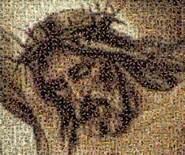 Since this coming week is Holy Week, I thought I would offer for your reflection this excerpt from my book The Fisherman’s Wife:
Since this coming week is Holy Week, I thought I would offer for your reflection this excerpt from my book The Fisherman’s Wife:
The next morning Esther and I help Lydia clear breakfast. Tobiah and Seth are out for a walk. Then seated on pillows with the two women and Leah, I tell them about last night’s strange meal. I’m interrupted when the two men enter the house out of breath. Tobiah says frantically with a stricken face, “They’re going to crucify Jesus. Pilate condemned him to death. They have him carrying a cross out to Golgotha right now.”
My heart stops. “Why are they doing this?”
Tobiah said, “They accused Jesus of treason, saying that he claimed to be king. He was arrested last night, betrayed by one of his apostles, Judas.”
“Judas!” I fairly spit out the name.
“All night Roman soldiers tortured Jesus and tormented him. They shoved a crown of thorns onto his head to mock him. They whipped Jesus so fiercely that people don’t think he will live to be crucified.”
I’m horrified. Possessing a vivid imagination, I picture the violence Jesus endured and what he looks like now and I shudder.
“People throng the streets, jeering at Jesus,” Seth says.
“Let’s go to support him,” I say. Turning to my daughter, I order, “Leah, you stay here and watch the children.” A crucifixion is gruesome, nothing a young girl should be subjected to. Crucifixion is the cruelest, most humiliating form of execution human beings have ever devised. It’s so abominable that Roman citizens can’t be crucified, only slaves and rebels.
The two women and I hurriedly leave the house with the two men. As much as I dread witnessing the suffering of Jesus, a man who would never make anyone suffer, I know I must be there.
It isn’t hard to find where Jesus is. We follow the roar of voices. Drops of blood splattered on the street show where Jesus passed. The route is through the busy narrow streets lined with vendors’ stalls so that as many people as possible can see him and be deterred from actions that threaten mighty Rome. We run through back streets and emerge on the road to Golgotha ahead of the mob. Among a group of sobbing women I spot familiar faces—Mary of Magdala, John Mark’s mother, and Salome. Esther, Lydia, and I join them. Between the heads of people standing before me, I glimpse Jesus, struggling to carry a rough wooden cross. His gentle, regal face is swollen and bloody, his white garment streaked with blood. How painful it was when I cut my hand a little on a broken clay jar. The slashes made by the lash of the Roman whips must be excruciating. Deeply moved at the pitiful sight, I feel hot tears coursing down my cheeks.
Jesus stumbles and falls on the rocky road, the heavy looking cross bounces brutally against his back, and onlookers gasp. A Roman soldier prods Jesus with a whip until he lurches up again and moves on, barely able to take a step. Another soldier grabs a dark-skinned man from the crowd and, pushing him toward Jesus, forces him to take the cross from Jesus and carry it. I doubt that the soldier is acting out of compassion; he is only determined to keep Jesus alive. If Jesus dies on the road, the populace will be deprived of the spectacle of the crucifixion.
Slowly we move toward the city gates with the crowd, an ugly tide of human beings. Oh, no! Across the road from us Mary, the mother of Jesus, walks along, her lovely face contorted with anguish. The apostle John is at her side with his arm around her. Good. He will catch her if she collapses. The poor lady. How can this be happening? Perhaps I’m trapped in a nightmare.
On Golgotha I huddle with the other women at a distance from where Roman soldiers are affixing three men to crosses. We are not so far away that I can’t hear the nails being pounded into the hands and feet of Mary’s son. I flinch at the sound of each dull clank. Then the crosses are hoisted up and dropped into the holes prepared in the ground, jarring the bodies of the condemned men. Mary and John move to stand directly beneath the cross. How can Mary bear this? She must be a very strong woman. If Jesus were my son, I would have fainted at the first sight of him on the road.
Where is my husband, Peter? I scan the groups of people watching on the hill, some sobbing, some gawking, and some gloating. I’m surprised to see Nathan and his wife. Deborah is nestled against Nathan’s side, seeking comfort from him as they witness the horror displayed before us. I don’t see any other apostle besides John. We stand there transfixed, watching the dreadful scene play out. Four soldiers are tossing dice next to a pile of clothes. I suppose they are dividing up the garments of Jesus that Mary lovingly sewed for him.
A few hours pass, and then Jesus gives a loud cry that wrenches my heart and his head drops down to his chest. I think he is dead. Roman soldiers strike and break the legs of the men on either side of him. That way the criminals can’t push themselves up to get a breath, and so they die. The soldiers go to the foot of the cross where Jesus hangs and confer. Suddenly one of them thrusts a spear into the side of Jesus, and I give an involuntary cry. What an ignominious end for such a noble human being. A little while later Tobiah walks over to the three of us and, taking Esther by the elbow, says, “It’s all over. Let’s go.”
I’m absolutely numb and move woodenly, oblivious to the people around me. No one speaks all the way back to the house. Although it’s afternoon, an eerie darkness cloaks the city, as though the sun is dying. My heart is pounding inside me, chanting, “Where is Peter? Where is Peter?” like a mantra.
How will you participate in the Holy Week rituals this year? Which one is most meaningful for you?










3 Responses
The Stations of the Cross is one very moving ritual for me. As we move through the stations, I try to put myself in first century Jerusalem.
Every year at St. Dominic’s, it is my privilege to lead the indoor Stations of the Cross. Not only are the prayers beautiful, but the faith of the people who gather for this prayer strengthens my faith.